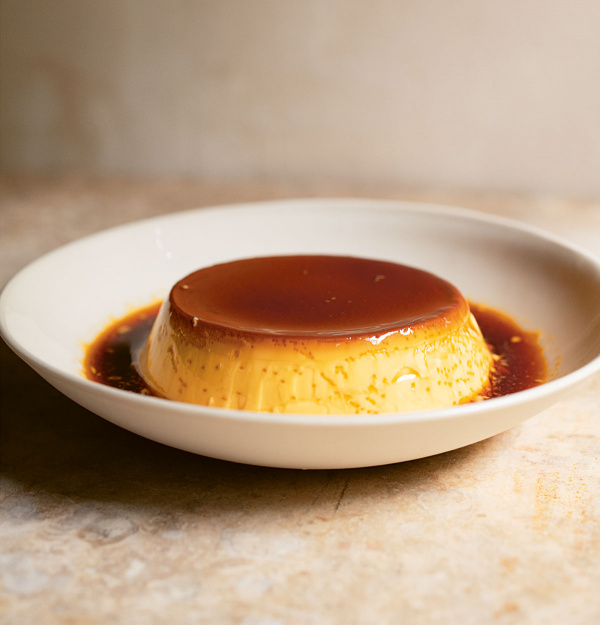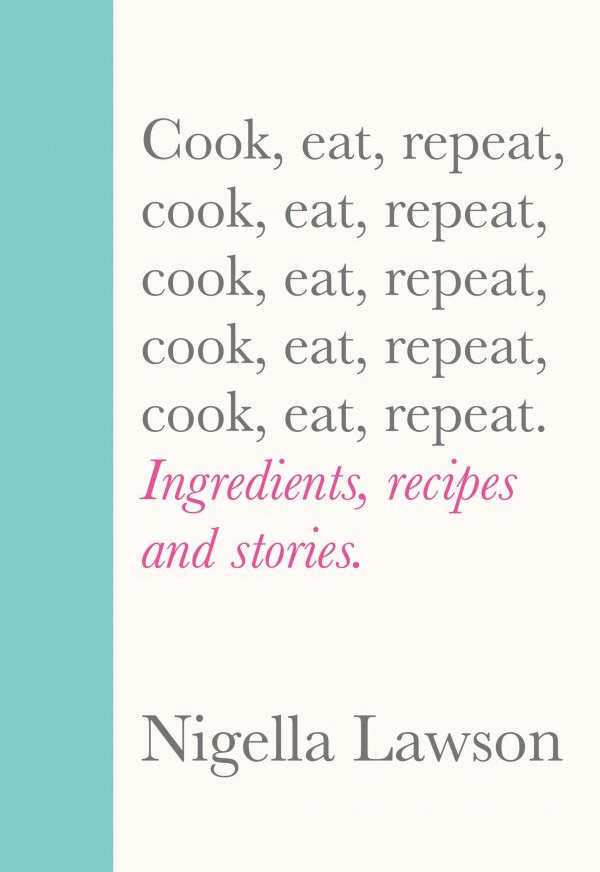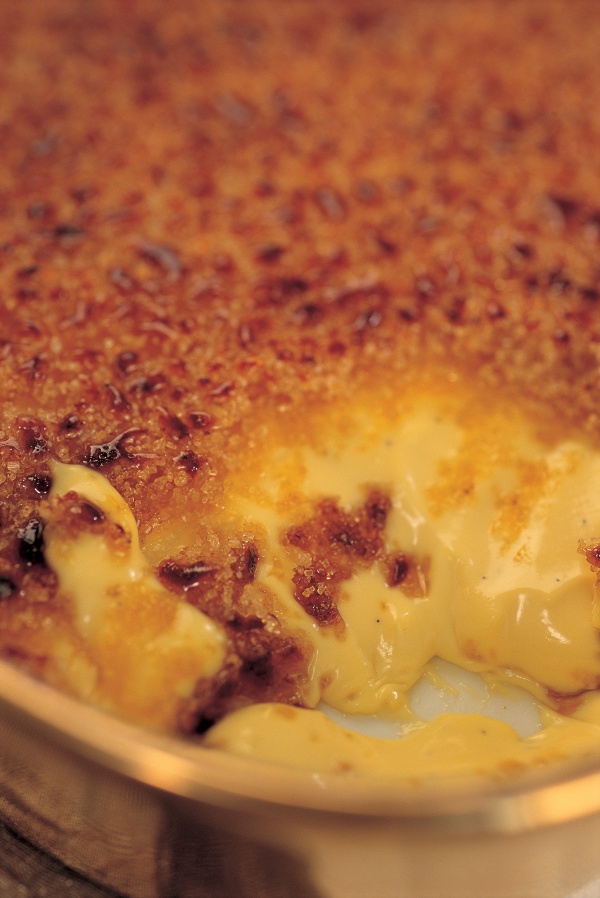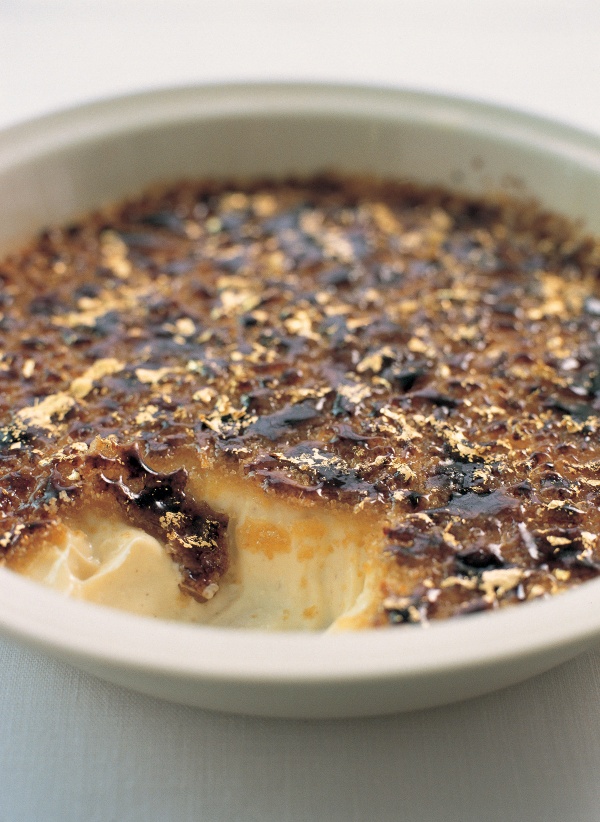Creme Caramel For One
by Nigella. Featured in COOK EAT REPEATIntroduction
I can't think of a better solitary treat: making something that needs unmoulding is nerve-wracking when you have to do it in front of people; alone, it gives a rather delicious frisson, and the bestowing of a hushed and hallowed moment. Creme caramel is just such a ridiculous thing to be making for oneself; therein lies the gift of it. And then there's the dreamy softness of the mild custard, the scorched syrup that counters it: eating it is a transporting experience.
I know it's customary to use both cream and milk in a creme caramel but to me it's the delicacy, the lack of richness, of the custard that gives it its teasing elegance. And, it's true, I used just yolks for it, rather than the more usual combination of whole egg and extra yolk, because that's what I needed to use up, but I would never toughen the texture of a creme caramel with an egg white again: this version is so exquisitely tender, its set so soft, it's like a whisper on the lips. That ethereal quality is partly, too, due to the way it's cooked. The water bath is routine enough, but covering it for the first 30 minutes it's in the oven helps it cook more gently still, as it protects the top from even the low heat it bakes at; it does need to be uncovered for the last 20 minutes, though, or else it won't hold its form when unmoulded later.
I can't think of a better solitary treat: making something that needs unmoulding is nerve-wracking when you have to do it in front of people; alone, it gives a rather delicious frisson, and the bestowing of a hushed and hallowed moment. Creme caramel is just such a ridiculous thing to be making for oneself; therein lies the gift of it. And then there's the dreamy softness of the mild custard, the scorched syrup that counters it: eating it is a transporting experience.
I know it's customary to use both cream and milk in a creme caramel but to me it's the delicacy, the lack of richness, of the custard that gives it its teasing elegance. And, it's true, I used just yolks for it, rather than the more usual combination of whole egg and extra yolk, because that's what I needed to use up, but I would never toughen the texture of a creme caramel with an egg white again: this version is so exquisitely tender, its set so soft, it's like a whisper on the lips. That ethereal quality is partly, too, due to the way it's cooked. The water bath is routine enough, but covering it for the first 30 minutes it's in the oven helps it cook more gently still, as it protects the top from even the low heat it bakes at; it does need to be uncovered for the last 20 minutes, though, or else it won't hold its form when unmoulded later.

Share or save this
Ingredients
Serves: 1, blissfully
For the caramel
- 2 x 15ml tablespoons (25g) caster sugar
For the crème
- 2 large egg yolks (at room temperature)
- 2 teaspoons caster sugar
- ¼ teaspoon vanilla extract
- 150 millilitres full fat milk
For the caramel
- 2 tablespoons (25g) granulated sugar
For the crème
- 2 large egg yolks (at room temperature)
- 2 teaspoons granulated sugar
- ¼ teaspoon vanilla extract
- ⅔ cup whole milk
Method
- Heat the oven to 140°C/120°C Fan/275°F, put the kettle on, tear off a piece of foil and cut out a square that's 1½-2cm / ¾in bigger than the diameter of the top of the dish or mould you're using. When I first rushed to make this, I used a sweet little 200ml / 7-ounce ceramic pudding basin that I must have bought once in a fit of cute, and found in the back of a messy cupboard. Fortune smiled: it was just right for the job. Otherwise, I favour preserving jars, drinking glasses or ceramic or glass ramekins; they all need to have a 200ml / 7-ounce capacity and be heatproof.
- Put your chosen mould very near the hob, and spoon the sugar into a very small saucepan with a light-coloured interior — I use my pixie-pan, more properly known as a butter melter, with a 9cm / 3½in diameter, but a milk pan about 14cm / 5½in is just as good — and add 2 teaspoons of cold water. Swirl the pan a little, then put over medium-low heat to melt the sugar and bring it to the boil, lifting the pan up and giving it a swirl every now and again. Don't even think of stirring it. Once the now-clear melted sugar starts bubbling away, you can turn the heat up a little, and then wait for it to turn first gold, then amber, then watch it until it's somewhere between maple syrup and chestnut; I like the caramel to be as dark and smoky as it can be without actually burning. Be patient, lift up and swirl the pan often and monitor it closely; as Tammy almost sang, Stand By Your Pan. Immediately it's turned the requisite deep amber, pour the caramel into the bottom of your mould, and now give this a swirl, just so the caramel goes a little up the sides. Place the mould in a small tin or ovenproof dish.
- In a Pyrex jug or similar, briskly stir the egg yolks with the sugar and vanilla extract, just until combined. I use a small silicon spatula for this, as a whisk would get too much air into the mixture.
- Warm the milk — I give it 40 seconds in the microwave — and then pour it over the eggs and sugar, stirring and scraping with your little spatula, making sure there are no visible yellow bits of egg left at the bottom. Strain this — you must not think of dispensing with this step — over your caramel-lined mould and then, with a teaspoon, carefully remove any bubbles or froth. Cover the mould with your square of foil, making sure it doesn't touch the custard mixture, and seal it well all around the edges.
- Pour hot water from the just-boiled kettle into the tin or dish to come about a third of the way up the mould, and slowly and steadily put it in the oven. Bake for 30 minutes, then lean in and very carefully remove the foil, and leave in the oven to cook for a further 20 minutes by which time it will be just set, with a little bit of a quiver.
- Remove the tin from the oven and very carefully lift the crème caramel mould out of the water, and leave it on the kitchen counter until completely cold. Cover with food wrap and place in the fridge overnight, or for at least 6 hours.
- Take the crème caramel out of the fridge 30 minutes before you want to eat it. Uncover, and with a very small palette knife, try very gently to pull the top of the soft-set cooked custard away from the sides of the mould. Fill a dish about 3cm / 1in deep with water from a just-boiled kettle, or very hot water from the tap, and stand or dip the crème caramel mould in the water for the count of 5. Now for the fun part: sit a saucer or small lipped plate on top of the mould, turn it swiftly and firmly the right way up and give the smallest of shakes to help dislodge it. You will hear a muffled squelch as the crème caramel begins to slide out of the mould and onto its saucer. Gently remove the mould, and gaze at this tender, bulging, copper-topped beauty for a moment, before you plunge in your teaspoon, and beome suffused, as you eat, by sweet serenity.
- Heat the oven to 140°C/120°C Fan/275°F, put the kettle on, tear off a piece of foil and cut out a square that's 1½-2cm / ¾in bigger than the diameter of the top of the dish or mould you're using. When I first rushed to make this, I used a sweet little 200ml / 7-ounce ceramic pudding basin that I must have bought once in a fit of cute, and found in the back of a messy cupboard. Fortune smiled: it was just right for the job. Otherwise, I favour preserving jars, drinking glasses or ceramic or glass ramekins; they all need to have a 200ml / 7-ounce capacity and be heatproof.
- Put your chosen mould very near the hob, and spoon the sugar into a very small saucepan with a light-coloured interior — I use my pixie-pan, more properly known as a butter melter, with a 9cm / 3½in diameter, but a milk pan about 14cm / 5½in is just as good — and add 2 teaspoons of cold water. Swirl the pan a little, then put over medium-low heat to melt the sugar and bring it to the boil, lifting the pan up and giving it a swirl every now and again. Don't even think of stirring it. Once the now-clear melted sugar starts bubbling away, you can turn the heat up a little, and then wait for it to turn first gold, then amber, then watch it until it's somewhere between maple syrup and chestnut; I like the caramel to be as dark and smoky as it can be without actually burning. Be patient, lift up and swirl the pan often and monitor it closely; as Tammy almost sang, Stand By Your Pan. Immediately it's turned the requisite deep amber, pour the caramel into the bottom of your mould, and now give this a swirl, just so the caramel goes a little up the sides. Place the mould in a small tin or ovenproof dish.
- In a Pyrex jug or similar, briskly stir the egg yolks with the sugar and vanilla extract, just until combined. I use a small silicon spatula for this, as a whisk would get too much air into the mixture.
- Warm the milk — I give it 40 seconds in the microwave — and then pour it over the eggs and sugar, stirring and scraping with your little spatula, making sure there are no visible yellow bits of egg left at the bottom. Strain this — you must not think of dispensing with this step — over your caramel-lined mould and then, with a teaspoon, carefully remove any bubbles or froth. Cover the mould with your square of foil, making sure it doesn't touch the custard mixture, and seal it well all around the edges.
- Pour hot water from the just-boiled kettle into the tin or dish to come about a third of the way up the mould, and slowly and steadily put it in the oven. Bake for 30 minutes, then lean in and very carefully remove the foil, and leave in the oven to cook for a further 20 minutes by which time it will be just set, with a little bit of a quiver.
- Remove the tin from the oven and very carefully lift the crème caramel mould out of the water, and leave it on the kitchen counter until completely cold. Cover with food wrap and place in the fridge overnight, or for at least 6 hours.
- Take the crème caramel out of the fridge 30 minutes before you want to eat it. Uncover, and with a very small palette knife, try very gently to pull the top of the soft-set cooked custard away from the sides of the mould. Fill a dish about 3cm / 1in deep with water from a just-boiled kettle, or very hot water from the tap, and stand or dip the crème caramel mould in the water for the count of 5. Now for the fun part: sit a saucer or small lipped plate on top of the mould, turn it swiftly and firmly the right way up and give the smallest of shakes to help dislodge it. You will hear a muffled squelch as the crème caramel begins to slide out of the mould and onto its saucer. Gently remove the mould, and gaze at this tender, bulging, copper-topped beauty for a moment, before you plunge in your teaspoon, and beome suffused, as you eat, by sweet serenity.
Additional Information
MAKE AHEAD:
Prepare up to 3 days ahead, cover and refrigerate. Remove from fridge 30 minutes before serving.
MAKE AHEAD:
Prepare up to 3 days ahead, cover and refrigerate. Remove from fridge 30 minutes before serving.






Tell us what you think
Thank you {% member.data['first-name'] %}.
Explore more recipesYour comment has been submitted.
What 1 Other has said
-
Posted by NanaAna on 19th January 2022
Show more commentsVery good but while I was doing all this for 1, I thought I might as well make 4!!! Just to invite someone, or be prepared for another meal, or be just downright greedy!